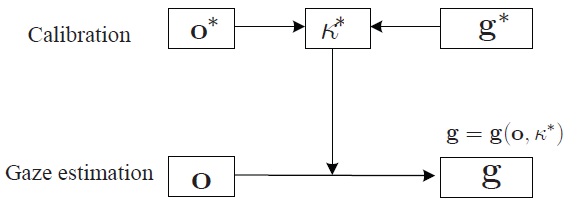|
Why not change the world ! |
|
Jixu Chen |
chenj4@rpi.edu |
Home | Research | Publications | Demos| Resume|
|
Probabilistic Gaze Estimation Without Active Personal Calibration |
|
Jixu Chen, Qiang Ji |
|
Existing eye gaze tracking systems typically require
an explicit personal calibration process in order to estimate
certain person-specific eye parameters. For natural human computer
interaction, such a personal calibration is often cumbersome and
unnatural.
We propose a new probabilistic eye gaze tracking system without explicit personal calibration:
|
| Comparison between the traditional gaze estimation and the probabilistic gaze estimation : |
|
|
|
Figure 1. Diagram of traditional gaze estimation o: optical axis estimated from eye image; g: gaze point (user's focus) on the screen; k: person-specific parameter of 3D eye-ball model which determines the relationship between g and o. |
|
In traditional gaze estimation system, the user is asked to look at some specific calibration points on the screen (g*). His/her eye parameter (k*) is estimated in this calibration procedure. |
|
|
|
Figure 2. Diagram of probabilistic gaze estimation p(g|I): probability of the gaze position given the image shown on the screen. It is computed as a saliency map. p*(k): Probability of the eye parameter estimated from saliency map. It is computed through incremental learning. p(g|I,o): probability map of gaze given the shown image and the optical axis.
|
| In probabilistic gaze estimation , our system can automatically update the eye parameter probability and estimate the gaze when the user is naturally looking at the screen. Our approach doesn't need the cumbersome and unnatural personal calibration. (Please check our paper for more details) |

